Menus
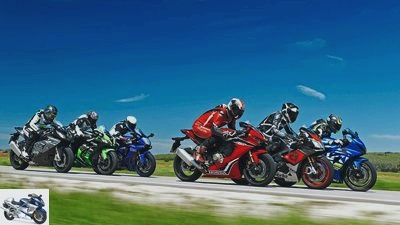
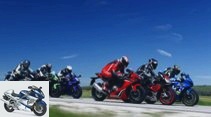

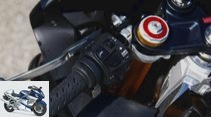

28 photos

factstudio.de
1/28
The 2017 superbikes were just battling it out on the racetrack, now the focus is on the country road, everyday properties are becoming more important. Master or fail is the exciting question.

factstudio.de
2/28
Built for fast driving, for the sporty curve frenzy. The means for this: extremely different!

factstudio.de
3/28
Aprilia RSV4 RR.
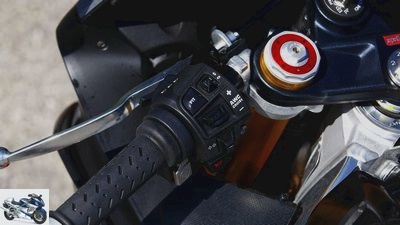
factstudio.de
4/28
Actually, the menu control works well with the small joystick, but it lacks clear locking points, you continue to click unintentionally.
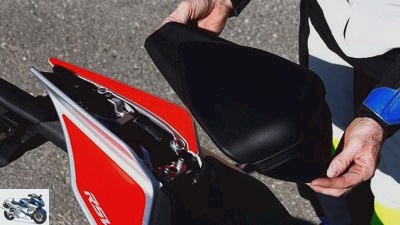
factstudio.de
5/28
It hardly gets any slimmer, this pad has to be enough for a passenger. A mixed pleasure – like on all other athletes.
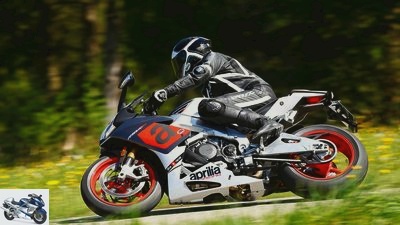
factstudio.de
6/28
The Aprilia is good at corners. High notches guarantee unpredictable inclination freedom, their cushioning offers comfort.

factstudio.de
7/28
Despite a lot of mass, the BMW sweeps neatly around the corner. For more stability, the rear axle is very far back in the swing arm.
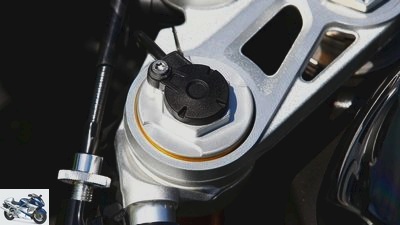
factstudio.de
8/28
At BMW, the electronics rule when it comes to chassis, the screwdriver for damping adjustment has had its day.

factstudio.de
9/28
As with the Aprilia, the pivot point of the BMW can be varied in height.
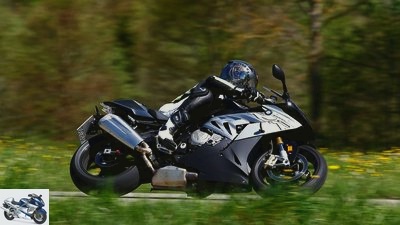
factstudio.de
10/28
BMW S 1000 RR.
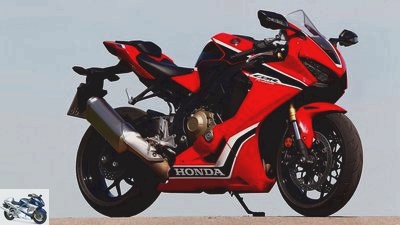
factstudio.de
11/28
Honda Fireblade.
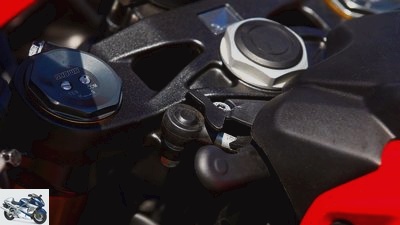
factstudio.de
12/28
This is where Honda’s electro-hydraulic steering damper is hidden, which effectively keeps the front quiet.
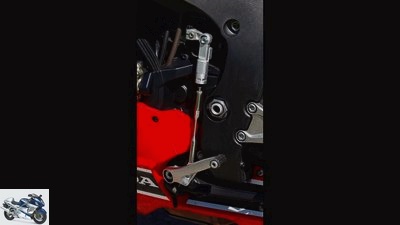
factstudio.de
13/28
Costs 699 euros extra, but is worth every penny: the ireblade’s blipper for quick gear changes.
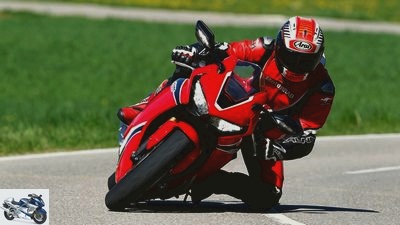
factstudio.de
14/28
The tight line is mine. None of the other sports bikes turns so precisely into curves, conveys so much confidence in an inclined position.
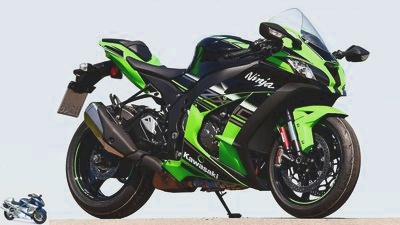
factstudio.de
15/28
Kawasaki ZX-10R.
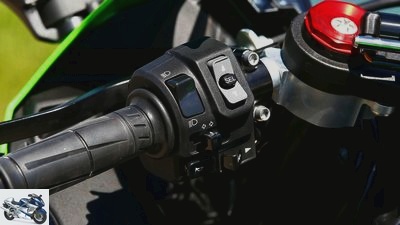
factstudio.de
16/28
The menus in the equally small, difficult-to-read cockpit can be changed using a small rocker switch.
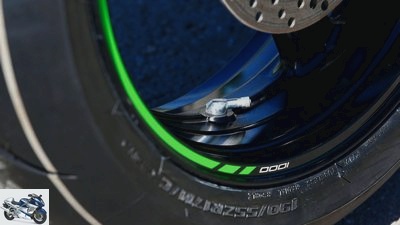
factstudio.de
17/28
It makes you happy when you reach for the air pressure gauge: there are cranked valves at the front and rear only on the ZX-10R and the Fireblade.
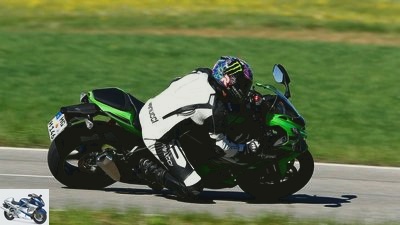
factstudio.de
18/28
Of course, the Kawasaki can also iron at an angle around the corner, but the wide tank and the footrests attached far to the front are a hindrance to efficient weight shifting.
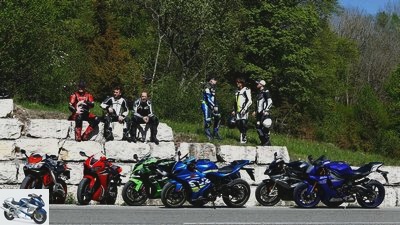
factstudio.de
19/28
A break on the superbikes cannot be avoided.
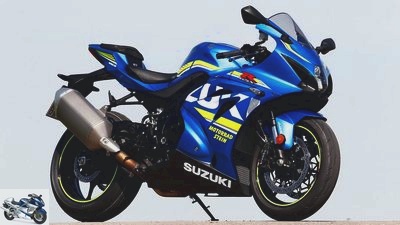
factstudio.de
20/28
Suzuki GSX-R 1000.

factstudio.de
21/28
Central control element to control all functions in the extensive dashboard. However, the operation is not intuitive.
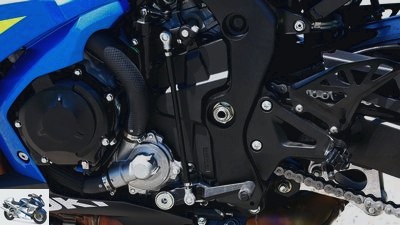
factstudio.de
22/28
Something is missing here: The GSX-R 1000 is the only motorcycle in the comparison without a quickshifter.
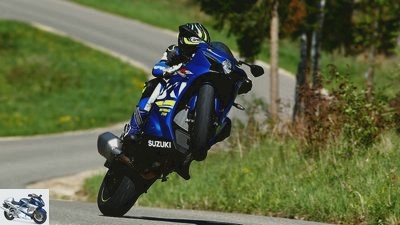
factstudio.de
23/28
The Suzuki pushes unobtrusively, but strongly, seduces you to unicycling despite a lot of load on the front wheel.
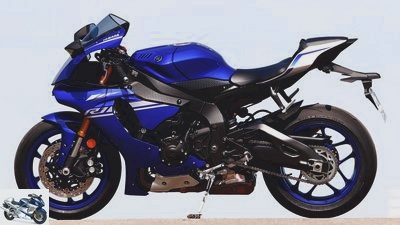
factstudio.de
24/28
Yamaha YZF-R1.

factstudio.de
25/28
Filigree rear of the R1, which can also carry a passenger in an emergency.
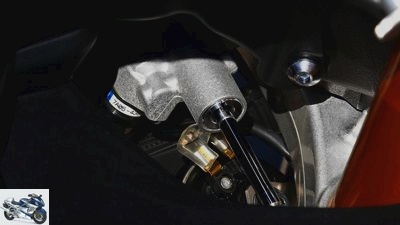
factstudio.de
26/28
Standard on all superbikes: the steering damper – here on
the Yamaha.
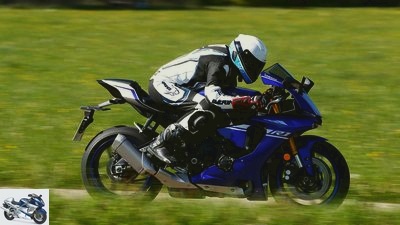
factstudio.de
27/28
MotoGP for the street: deep stubs, high seats and a large field of start numbers on the front. None of them convey racing spirit anymore.
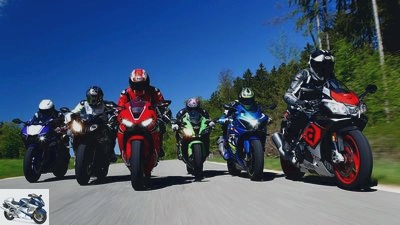
factstudio.de
28/28
2017 super sports car in the country road comparison test
2017 superbikes
A moment ago the superbikes BMW S 1000 RR, Kawasaki ZX-10R, Yamaha YZF-R1, Honda Fireblade, Aprilia RSV4 RR and Suzuki GSX-R 1000 from 2017 were battling it out on the racetrack, now the focus is on country roads, gaining everyday properties in importance. Master or fail is the exciting question.
Issue 9/2017 was all about one thing: the best racetrack performance. All superbikes from Aprilia to Yamaha faced the shootout for lap times in their respective premium versions. They are now in the background. The highway is calling. And again the wild Superbike pack is assembled. However, the basic variants of the high-performance athletes with their wide tires are now scraping, wanting to prove that they are not only fast and sloping, but also suitable for everyday use. Curtain up for the weird sextet from Aprilia RSV4 RR, BMW S 1000 RR, Honda Fireblade, Kawasaki ZX-10R, Suzuki GSX-R 1000 and Yamaha YZF-R1. Wait, isn’t there one missing? Right, Ducati is not there with the 1299 Panigale.
Buy complete article
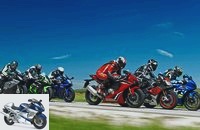
2017 super sports car in the country road comparison test
2017 superbikes
RSV4 RR racing. Highly visible stickers impressively report the world championships in motorcycle racing. In addition, it is the only one to offer an adjustable steering head angle and a height-adjustable swing arm bearing. In addition, the rear brake fluid expansion tank is integrated directly into the brake pump. It couldn’t be lighter or more compact. But before we spend too much time in the pit lane, get on the Italian horse. Anyone who has ignored the racing roots of the RSV4 up to then can now experience it first hand. The pegs are set high, and the driver crouches just as far from the ground. A seat height of 845 millimeters is a word. As if by themselves, your knees slide into the bulges on the narrow tank. No other motorcycle in the six-pack comparison offers such a tight knee joint.
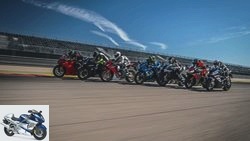
Super athlete
Seven superbikes in the racetrack test
What makes you fast
read more
The stub handlebars lie deep in your hands, but are very pleasantly cranked. These are exhibited very broadly, from which the lever arm benefits. After pressing the starter, the only V4 of the test is there immediately. The gears slide back and forth in city traffic using a blipper – which, however, has long interruption times in the lower speed range. And the engine is already making it clear that it is not at home at low speeds. The Aprilia regards everything that happens below 5000 rpm as a necessary evil. The drive announces this unwillingness with a clattering background noise. Let’s draw a line under this chapter and give the 13.6 to 1 highly compressed engine what it demands: speeds.
When the RSV4 is allowed to let off steam in the upper speed range, the athlete wakes up from his deep sleep and Dracula gets the life-giving blood ration. And that really awakens the Aprilia spirit. The 65-degree V4 marches willingly upwards, turning loosely and flaky up to the performance zenith at 13,000 revolutions. At this speed, the rear 200cc Pirelli Diablo Supercorsa SP 201 has to transfer horsepower to the asphalt. Before it goes up in smoke, the adjustable traction control saves his rubber reserves. So you can dash towards the next bend with a lot of momentum. Before that, quickly stepped down two gears without using the clutch and braked the RSV4 down to the correct cornering speed with two fingers. The stoppers – 330 mm discs, Brembo M50 pliers including radial pump – allow precise hits when aiming at the correct turning point, and can be dosed down to the apex.
And because the three-way adjustable ABS is in no way inferior to this performance, the Aprilia can be decelerated safely and without stopping even with a pillion passenger. Whereby a passenger can still bear the knee angle, but finds little support on the small, slippery cushion. The chassis does not take the extra weight so easily. When loaded, the Aprilia, which is easy to handle in solo operation, hangs deep in the spring, making its everyday use, not too tight coordination noticeable. In contrast to the Ohlins spring elements of the RF version, the Sachs elements of the “RR” are designed to be softer. That takes away the horror of bumpy slopes, but the reserves are running out. The Aprilia can also be lavish. That shows the consumption. The V4 draws 5.9 liters on a leisurely 100 kilometers. Mamma mia.
But do it. It’s no different in the Mia-san-mia department. The BMW doesn’t skimp on fuel either, it’s 5.6 liters for the 100-kilometer distance. Too much, no question. But: It is pure joy to ask the smoky row four to work. Regardless of whether it is in the lowest speed range, on medium tours or cheering in five figures, this engine knows no weakness. No superbike pushes forward more strongly. This can be seen from the acceleration values. 0–200 km / h in seven seconds. Otherwise only the Suzuki can do that. The S 1000 RR could be even faster, but up to the 100 mark the high power becomes an obstacle because it constantly pushes the front up and not forward. With a lot of weight on the front wheel, the Suzuki is more sprinting.
But back to the BMW. It not only inspires with pure power, but also with its superb responsiveness. Opening the throttle valve wide at the apex succeeds with flawless transitions. There is nowhere to hack and bend.
Also nice: the blipper, available as an option. Although it doesn’t work as accurately as its Honda counterpart and lacks precise feedback, especially when downshifting, it is a blessing as it relieves the clutch hand. Because: A clutch lever that protrudes further from the handlebars cannot be found in any BMW parts store in the world. As with all other non-adjustable levers, even huge XXL paws have difficulty reaching the lever.
What is also noticeable: the years are slowly gnawing away at the S 1000 RR. Introduced in 2008, it has always remained true to its basic features. This is particularly true of the sitting position. In contrast to the Aprilia, it positions the pilot further back and lower, which is why he has to stretch more over the tank. An arrangement that does not offer the crisp, combined sportiness of newer bikes without collecting significant plus points in seating comfort – see the new Fireblade. Old-fashioned would be too negative, conservative is a good thing. Regardless of the seating comfort, the S 1000 RR is still one of the fastest bikes in its class.
In addition to the powerful engine that mobilizes 199 hp at 13500 rpm, this is also due to the brakes. Nobody else grabs so vehemently. Small lever travel paired with brutal deceleration – the braking effect is right. However, a few clouds darken the delay sky, because on the one hand the fat gripping makes it difficult to control and on the other hand the pressure point moves towards the handlebars after brisk stops in the back and forth curves. However, this has no influence on the ABS and its effect. In conjunction with the semi-active chassis, which is built in as an extra, the S 1000 RR remains stable on its lane even with a pillion passenger, even with the shortest possible stopping distance, nipping every stoppy approach in the bud. Well done. However, the chassis does not act at such a high level during curve dancing. Maximum weight of 214 kilograms with a full tank and the wheelbase, which is 1438 millimeters long, so the double-R doesn’t wipe the corner too easily, lacks a little stability in long, fast arcs because of the slightly touching hindquarters. Mind you: This is the proverbial complaining at the highest level, but others show that it can be done better.
And one of those is the Honda Fireblade. To say it right at the beginning: It is the weakest performance motorcycle in this comparison, but a few ponies owe the promised 192 horsepower of the factory specification. The test bench reports 186 of them. The Honda puts away the slaps like nothing. Okay, when it comes to performance it is not in the top field, but when it comes to the chassis, it shows others what is currently going on. The 43 mm upside-down fork and shock absorber feel their way sensitively over the relief of the road, smoothly ironing warps with a smooth response without losing the necessary stability. Quite the opposite: the shortest wheelbase together with the Yamaha, the steepest steering head angle together with the Kawasaki and a short caster are not the best prerequisites for this, but the chassis seems to know almost telepathically what is coming next. It simply compensates for high loads when braking or accelerating with ideal damping. The handling of the Fireblade also benefits from this very successful set-up, as does the lowest weight of the six motorcycles. 198 kilograms with a full tank are really little, measured 28 pounds less than the predecessor. The fire blade wipes around the corner with the lowest steering force and the highest precision, and delivers a lot of trust-giving feedback even in deep inclines. madness.
Thanks to compact, front-wheel-oriented, but not uncomfortable ergonomics, it is easy for the driver to use the chassis potential when swinging through the bends, weight shifting from left to right and back works by itself. The same applies to gear changes, which are due to the optional blipper (699 euros extra) succeed cleanly. With so much praise, the brakes don’t want to be left behind. With a fixed pressure point and easy dosing, the Blade easy can be compressed up to the apex. From then on the engine is on again: throttle valves open!
And it is precisely at this moment that there is a problem. When the country road turns into a narrow Mickey Mouse runway, braking and acceleration are practically every second, the Honda grabs when you apply the gas. The apex has passed, we should move forward again – but unconsciously, the rider in a hurry is always waiting for the brief jolt when applying the gas again. Only then does it continue quickly. The responsiveness in the various driving modes does not spoil the line, but it is really annoying. And so much can be revealed: All in all, the dream of victory for the Honda is over.
What is also noticeable: After a cold start, your engine revs up for an unusually long time and continues to push itself even when the gas is closed. The others manage it better. And because the criticism mode is currently activated: The small pane is not suitable as a windbreak. If you want to hide behind it, you can’t be much bigger than a dwarf. What both short and long, however, like unreservedly, is the gasoline consumption of the Honda. 4.9 liters are in the books as the result of the consumption round. Which proves: With little fuel you can really have fun, because the Fireblade offers that when drifting at an angle with its loose, flaky nature with every meter. Even in city traffic, you like your engine with its smooth running, coping with annoying compulsory tasks with a lot of serenity.
It is now receding into the background. The Kawasaki wants to show what it can do. After all, the two racers Jonathan Rea and Tom Sykes underline the potential of the green in every race of the Superbike World Championship. In addition, the wonderfully blue shimmering titanium manifolds arouse further racing associations. But doubts arise during the seat rehearsal. The knees are wide, the tank is long, and the footrests are far forward. This arrangement is not uncomfortable, but compared to the other test bikes you miss a pinch of active sportiness. Perhaps a higher seat cushion would help, as the ZX-10R places its pilot at the lowest position with a seat height of just 815 millimeters.
On the other hand, the view in the mirrors is good. No one else comes close. What gets stuck much more when bustling through the city traffic: The engine has a lot of trouble when pulling up the speed ladder. In the lower speed range, he works sluggishly. In the city you can still get over that, but in the country it is difficult. As a result, this means that if the Kawa wants to keep up with the other, it almost always has to be driven down a gear. A shorter translation would be a solution. But it’s not just the engine that prevents the Kawasaki from cornering fun. There is also room for improvement in the chassis. As a look at the data shows, the ZX-10R has the longest wheelbase, the flattest steering head angle and the longest caster. Sure, this does not necessarily determine the driving characteristics, but in the case of the Kawasaki it is true that the ZX-10R runs better in a straight line than to provide joy in the maze of turns. Unhandy and with a slightly diffuse steering behavior, it falls in curves. It is not easy to always hit exactly the desired turning point – especially because all the others roll into the corner much more harmoniously in a direct comparison. The spring elements, which are at eye level with the competition, do nothing to change that. Even if the fork, which is the only one equipped with a separate expansion tank, guides the front wheel well, the rear shock absorber should be just a little more sensitive – the ZX-10R remains a stubborn fellow. To make matters worse, the seating position described does not support the driver’s weight transfer to the inside of the curve.
If you don’t mind the pillion of your athlete, you are welcome to include the Kawasaki in the shortlist. Although the ZX-10R tends to spontaneous stoppies when there is a delay in the ABS control range, the seating position in the second row is great in this environment. The knee angle for the passenger is bearable and the contact with the driver is good. So it can go further than the next ice cream parlor.
The Suzuki developers certainly did not primarily think of the pillion when the GSX-R 1000 was reissued. Rather, the word power was at the top of the requirements booklet. And more power. For the previous model, the data sheet showed 185 hp. But the competition, especially BMW, put a lot of effort into it. That had to be different. Which is why the new GSX-R 1000 should let 203 horses start to trot at 13,200 revolutions. At least in theory. In practice, with 193 hp, it is ten horsepower less, but what does that matter? After all, the old model only had 175 instead of the stated 185 hp. The bottom line is that the new GSX-R has a 20 HP power advantage over the old one. The Suzuki uses it for tight driving performance. They also come about because they put a lot of weight on the front (108 kilos at the front, 98 kilos at the rear), their front wheel does not rise towards the sky as much as the BMW does. As a result, this means: The GSX-R 1000 is now on par with the S 1000 RR.
Although this only applies to the pure acceleration and pulling power measurements under full load. In real life, the throttle valves are seldom all the way up; a brisk approach with smaller opening angles is much more important. And the Suzuki doesn’t quite come close to the Bavarian four-man. This is partly due to the fact that the GSX-R 1000 responds with a slight delay when the gas is applied, as if the throttle valves wanted to remain in their original position for a brief moment before releasing their 43 mm cross-section. Nevertheless: Together with the BMW, there is no way around the Japanese in the engine classification.
It looks a little different with the chassis. Similar to the BMW and the Kawasaki, the rider sits slightly inactive on the motorcycle, the tank is wide, and his arms stretch forward to the handlebars. In combination with the heavily front-heavy weight distribution, the handling suffers, and the GSX-R 1000 requires clear impulses in order to dive into an inclined position. That, just like slight deficits in the feedback, ensures overall a good result, but not the best values. You get it with the equipment. No other dashboard in the comparison offers more information than the Suzuki cockpit, although the readability of the LCD screen leaves room for improvement with the many displays. Positive: Like the Kawasaki, the Suzuki has luggage hooks on the pillion pegs. The others do without it.
The brakes should respond more crisply. The effect is correct, but the brake lever of the radial pump is close to the handlebars even in the widest setting. And because, as with the BMW, the pressure point moves to the handlebars after several delays, there is no possibility of readjustment. So you always feel a bit more likely to grab the stoppers, give away a few meters on the brakes. Of course, this is not relevant when driving fast country roads, but it is noticeable in comparison with the others and their better performance from this point of view.
The direct confrontation with the competition also reveals how good the Suzuki’s windbreaker turns out to be when driving on the Autobahn. The window effectively shields the driver from the oncoming hurricane. Since the driver’s seat to the rear is really generous, the hurried Suzuki trainer can slide far back to hide behind the window.
The straight-ahead bolt is a piece of cake for the chassis. As if pulled on a string, the Suzuki pulls its fast track. Nothing changes in this solid performance as soon as the ticket to the cornering area is obtained by exiting the motorway. Here, too, the GSX-R 1000 turns out to be a reliable partner and does everything. The only problem with the Suzuki remains: some do it a bit better, speak more sensitively, give more feedback. The air in the upper class is thin on the level of all superbikes. So it is often the nuances that make a difference, that make the difference for better or for worse.
The pricing of the Suzuki as an introductory offer is far from that, because it makes it clear here: I am good and really cheap. 15990 euros are on her list. In the tested versions, the Gixxe is at least 1500 euros below the competition. Although she is the only one who has to do without an automatic switch, the difference remains a clear one. And because the Suzuki, like the Honda, only needs to be serviced every 12,000 kilometers, the follow-up costs are kept within reasonable limits.
Such a sober approach to superbikes? The Yamaha YZF-R1 only wrinkles its pointy nose. Like the Aprilia, its purpose is to be quick. It is tailor-made for this. Her stern alone. Only the R1 is so filigree. The openings visually emphasize the lightness. In addition, the headlights required for approval are almost shyly hidden next to the huge air intake on the front. You are welcome to stick your own start number on it – the field for this is already provided. There is also an openwork upper triple clamp. If you have a passion for racing, you quickly think of these ingredients as Rossi or Viñales on your own home track.
But as I said: As with the RSV4, this very racing bike-like design also requires compromises in everyday life. It starts with sitting. The handlebars are nowhere deeper than on the Yamaha. Driving downhill serpentines, possibly using the excellent deceleration of the front brake, is only one thing: really exhausting. Only when the R1 is allowed to run and the curves become wider does its concept develop. Then the Yamaha sweeps through arches in a stable, precise and extremely manageable manner, even at brisk pace, the front wheel reports almost unfiltered what is happening under the tire. This positive feedback is also retained when the damping on the fork and shock absorber is opened further for more comfort. In the delivery condition of the test motorcycle, the compression stage and especially the rebound stage were very tight at the front and rear. With a few clicks less, the R1 ironed patches in a more relaxed manner without losing precision. It only gets tricky when a pillion rides on. With the quick ABS stop, there is a free stoppage guarantee.
The crossplane foursome is still missing. It works true to the motto “Love it or leave it”. Little happens to him below 7000 rpm, above that the hut burns, the pistons only sweep through the cylinder bores until 200 hp at 13,500 rpm are reached. A curse in everyday life, a blessing for many in knife-between-the-teeth mode.
The latter applies to all superbikes overall. Despite the losers and winners: The six horses in a hurry don’t do anything really bad – except maybe the pillion transport – they definitely get a lot of points. If you like it sporty, you will not find a more exciting, faster, or more inspiring way to give in to your weird lust – no matter which is the secret favorite. And that’s pretty good in itself, isn’t it?
MOTORCYCLE test result
1. BMW S 1000 RR
There is still no other superbike that can match this engine on the country road, which is why the BMW comes out on top. The air up there is slowly getting thin because the S 1000 RR is no longer state of the art in terms of chassis and fuel consumption.
2. Honda Fireblade
What a debut. The least powerful motorcycle lands in second place by a wafer. Which proves: Power is only one side of the coin, with its chassis, the Honda outperforms the competition.
3. Suzuki GSX-R 1000
Before that you can take your hat off: The Suzuki has gotten much better and has clearly caught up with the leaders in terms of points. Your engine is a force, the chassis still has room for improvement. A top offer at an introductory price.
4. Yamaha YZF-R1
Your engine likes speeds, then pushes properly. The ergonomics are sporty and crisp. These are pluses on the racetrack, but they have a negative effect in everyday life. Just like the excessive consumption of the crossplane quad.
5. Kawasaki ZX-10 R
In everyday life, the Kawasaki is at the forefront, even a pillion passenger likes to ride. But otherwise? Due to the long gear ratio, the engine does not get out of hand and the chassis is not very agile. There would be more to it.
6. Aprilia RSV4 RR
The injustice of the point table: consumption, seating comfort for driver and passenger, load changes or smoothness – the Italian leaves points everywhere. Above all, she is really good at one thing: driving fast. It needs curbs and not curbs.
Price comparison of used 1000 super sports cars
1000PS marketplace app
On the used market you can find a variety of used 1000 super sports cars.
Thanks to their great popularity, 1000ccm super athletes are strongly represented on the used market. Most of the specimens are still standard, or only slightly modified, while one or two racetrack conversions can also be found. Here you can find all 1000 super athletes from this comparison test: used 1000 super athletes in Germany.
Related articles
-
Comparison test of the 1000 super sports car
Jaime de Diego 38 pictures fact 1/38 Yamaha demands 14895 euros for their completely new R1 super sports car. fact 2/38 Even without ABS, the Fireblade would …
-
Comparison test of the 1000 super sports car in 2006
fact comparison test of the 1000 super sports car 2006 The show must go on The mystery repeats itself. Whenever we think that there is nothing more …
-
Comparison test of superbikes, part 1: Country road
Jorg Kunstle 36 pictures 1/36 Comparison test Superbikes: Aprilia RSV4 RF, BMW S 1000 RR, Kawasaki ZX-10R, Yamaha YZF-R1M. 2/36 …
-
Comparison test of the 600 super sports car
Ducati 748 R comparison test, Ducati 748, Honda CBR 600 F, Kawasaki Ninja ZX-6R, Suzuki GSX-R 600 600 super athletes in the test Fireworks! Kawasakis …
-
Comparison test of the 600 super sports car
Comparison test of the 600 super athletes There is close turmoil in the athletes’ faction. A whopping 124 hp, a ridiculous 207 kilograms with a full tank, pure, sensual …
-
BMW, Honda, Kawasaki, Suzuki and Yamaha super sports cars in a comparison test
Judd 26 pictures Nicolaou 1/26 In the super sports car comparison test: Kawasaki ZX-10R, BMW S 1000 RR, Suzuki GSX-R 1000, Honda Fireblade C-ABS and Yamaha YZF-R1 ….
-
Superbikes 2012 – The super athletes on the country road
30th photos 1/30 The super athletes: Aprilia RSV4 Factory APRC, BMW S 1000 RR, Ducati 1199 Panigale S, Honda Fireblade,…
-
Comparison test of the 1000 super sports car, part 2
Jahn comparison test 1000 super sports car, part 2 The street sweepers Fun country road surfing, everyday operation, sober cost-benefit calculation ?? in the…
-
Comparison test of the 1000 super sports car, part 1
Jahn comparison test 1000 super sports car, part 1 The full range Slim, strong, ready to attack, with the Suzuki GSX-R 1000 is the field of …
-
Comparison test: fun on the country road
Jahn comparison test: fun on the country road Street sweepers Winding country roads are the culmination of every motorcycle tour. But how far does the fun hang …